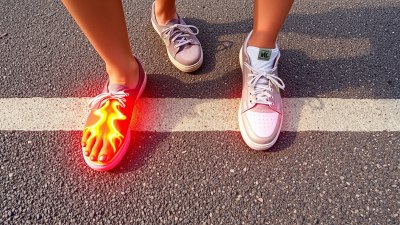How Hot Pavement Can Actually Burn Through Shoes
Explore how extreme pavement heat can cause burns and damage even through shoes, affecting foot safety in summer.

During the summer months, when temperatures rise significantly, the heat absorbed by pavement can reach alarming levels, posing hidden dangers to pedestrians. One such threat is the potential for hot pavement to cause burns not only to bare feet but also through the soles of shoes. This phenomenon is more common than many realize and underscores the importance of understanding how heat transfers through materials and the risks involved in walking on sun-baked surfaces.
To grasp how hot pavement can burn through shoes, it is essential to first understand the properties of pavement materials and how they absorb and retain heat. Pavement, typically made of asphalt or concrete, absorbs solar radiation throughout the day. Asphalt, in particular, is a blacktop material known for its high solar absorption rate, which causes it to become exceedingly hot under direct sunlight. Studies have recorded asphalt surface temperatures rising well above the air temperature, sometimes reaching as high as 140 to 160 degrees Fahrenheit (60 to 71 degrees Celsius) on very hot days.
The heat retained by pavement influences not only its surface temperature but also the heat transmitted to objects in contact with it, including footwear. When someone walks on scalding asphalt, the heat transfers through the shoe sole, potentially causing discomfort or even burns. Although shoes provide some insulation, they are not impervious to heat. Certain shoe materials like thin rubber, synthetic soles, or flip-flops offer limited protection against high surface temperatures.
The thermal conductivity of shoe soles varies depending on the materials used. Rubber, EVA foam, leather, and plastic each have different capacities to act as heat barriers. Thin soles made from single-layer rubber or plastic transfer heat more readily than thicker, layered soles or those with added insulative materials. Therefore, individuals wearing flip-flops, sandals, or shoes with thin soles are more at risk of experiencing burns on hot pavement.
Another critical element is the duration of exposure. Standing or walking barefoot or in insufficiently protective footwear on hot pavement for even a short time can cause skin burns. The same applies when heat transfers through shoes, primarily if a person stands still or walks slowly, allowing heat to accumulate against the skin beneath the sole. Prolonged contact increases the chances of heat penetrating through the shoe material, resulting in discomfort, blisters, or burns on the feet.
Researchers in burn and dermatological studies have demonstrated that skin can start to burn at temperatures as low as 111 degrees Fahrenheit (44 degrees Celsius) when exposure times last several hours. However, at higher temperatures, burns can occur in just seconds or minutes. Given that pavement temperatures often surpass 130 degrees Fahrenheit on hot days, even footwear must provide sufficient insulation to prevent thermal injury.
Beyond the physical properties of materials, environmental factors such as direct sunlight intensity, time of day, pavement color, and humidity influence the heat level of the pavement. Darker pavements absorb more heat than lighter-colored surfaces. Asphalt is generally darker than concrete, leading to higher surface temperatures. In cities with large expanses of asphalt roads, this effect is even more pronounced, sometimes contributing to the urban heat island effect.
Urban heat islands are areas where asphalt, concrete, and other man-made surfaces concentrate heat, raising the local air temperature and the temperature of the ground. This consequently increases the heat risk posed by pavement to pedestrians. On extremely hot days, the pavement can reach temperatures detrimental to both bare skin and the materials of common footwear.
Footwear design plays a critical role in protecting from hot pavement burns. Shoes built with thicker soles, breathable linings, and insulating materials reduce heat transfer to the foot. Hiking boots and many sport shoes often include layers designed to buffer heat and provide comfort on varied terrains. Conversely, shoes primarily made for fashion or convenience, such as thin sandals or flip-flops, prioritize aesthetics over heat protection and present greater burn risk in hot environments.
In addition to sole thickness, the shoe design affects exposure. Open footwear exposes more skin to radiant heat, increasing the risk of burns not only on the sole but other parts of the foot. For this reason, closed shoes with protective uppers are recommended for walking on hot surfaces in summer conditions.
Children, elderly individuals, and people with certain health conditions are especially susceptible to thermal injuries from hot pavement. The skin of children is thinner and more delicate, increasing vulnerability to burns. Elderly individuals may have impaired sensation, preventing them from detecting the early signs of heat discomfort. Similarly, people with diabetes or peripheral neuropathy often have reduced foot sensitivity, leaving them unaware of potential burns until damage occurs.
Preventative strategies to minimize burns from hot pavement encompass both behavioral and structural approaches. Wearing appropriate footwear with insulating soles and closed designs reduces direct heat transmission. Limiting time spent walking or standing on exposed pavement during peak heat hours (typically between 10 a.m. and 4 p.m.) lowers exposure risk. Seeking shaded or cooler surfaces such as grassy areas or shaded sidewalks can also mitigate exposure.
Moreover, urban planners and municipalities can help by selecting pavement materials and colors that reduce heat retention. Innovations like lighter-colored asphalt, permeable pavements, reflective coatings, and increased tree canopy coverage all contribute to cooler walking surfaces. These structural changes not only protect pedestrians but also reduce the broader urban heat island effect contributing to health risks citywide.
It is also crucial to recognize symptoms of heat-induced foot injuries promptly. Early signs include redness, tingling, swelling, and pain on the sole or exposed skin. Ignoring these symptoms can lead to blisters, skin peeling, or more severe burns requiring medical intervention. Should any burn symptoms appear after walking on hot pavement, cooling the affected area with cool water, avoiding further heat exposure, and seeking medical advice if necessary is advised.
Besides individual precautions, public awareness campaigns help educate communities about the dangers of hot pavement and the importance of suitable footwear during summer. Messages emphasizing the risk of burns through shoes and safe walking practices encourage vigilance and protective behaviors among pedestrians, caretakers, and parents.
In relation to footwear materials, research continues to develop innovative solutions that provide both comfort and protection against thermal injuries. Advances such as heat-reflective coatings inside shoes, materials with lower thermal conductivity, and sole designs that dissipate heat quickly have potential to improve pedestrian safety significantly.
While most people associate foot burns primarily with barefoot walking, the reality that hot pavement can burn through shoes reinforces a more cautious approach to summer footwear choices. Recognizing the interaction between pavement temperature, shoe material, and exposure duration enables individuals to make informed decisions, prioritizing safety and comfort during hot weather.
The phenomenon whereby hot pavement burns through shoes highlights an intersection of physics, material science, and human health. Heat transfer by conduction, influenced by the properties of soles and skin sensitivity, creates a tangible risk that requires attention. Such injuries are preventable through education, proper footwear design, and environmental management.
Understanding the mechanics of heat conduction is central here. Heat moves from a high-temperature surface (pavement) to a lower-temperature object (shoe sole), ultimately reaching the skin. The rate of heat flow depends on factors such as the thermal conductivity of the sole, thickness, and contact time. Materials with high thermal conductivity and thin profiles allow faster heat transfer, increasing burn risk. Conversely, materials with insulating properties reduce thermal penetration.
Physiological aspects also influence injury risk. Foot skin varies by thickness across the sole, with thinner areas more vulnerable to damage. Sweat and moisture can affect heat transfer as wet surfaces conduct heat differently, sometimes increasing discomfort. Additionally, footwear trapped heat can compound the thermal load on feet.
Personal reports and case studies document instances of burns developing from walking on hot pavement despite wearing shoes. Some case reports describe patients presenting with blisters or partial-thickness burns on the feet associated with exposure to hot asphalt or concrete in summer. These highlight a practical application of scientific understanding to real-world scenarios.
For those planning outdoor activities such as hiking, running, or errands during hot weather, recognizing pavement heat as a potential hazard is crucial. Preemptive measures like carrying alternate footwear, avoiding peak heat hours, and checking pavement temperature with the hand before walking barefoot or in thin shoes can prevent injury.
When it comes to public safety, certain locations such as playgrounds, parks, and walking trails may be especially prone to elevated surface temperatures, often unnoticed by visitors. Installation of heat warning signs and accessibility to shaded rest areas enhance visitor awareness and comfort.
The implications extend beyond immediate foot injuries - consistent exposure to high pavement temperatures can contribute to chronic foot conditions such as calluses, skin breakdown, or infections due to repeated thermal irritation. These conditions require careful management and reinforce the value of protective footwear.
In summary, hot pavement during intense summer heat poses a hidden but significant risk capable of causing burns even through shoes. The scientific principles of heat transfer combined with material characteristics of footwear and skin sensitivity define the degree of risk. Awareness, suitable footwear selection, timely behavior adjustments, and environmental management collectively reduce the potential for injury.
By integrating knowledge about thermal properties of pavements and footwear with practical safety tips, communities can reduce burn incidence and enhance comfort during hot weather activities. Wearing thick-soled, insulating, and closed shoes, avoiding prolonged contact with sun-heated surfaces, and engaging in urban cooling efforts represent key strategies to mitigate harm.
As ongoing research improves materials and urban planning addresses heat concerns, the danger of hot pavement burns can be minimized. Until then, recognizing the threat and adopting preventive measures remains a primary defense for pedestrians facing summer heat challenges.
Understanding these risks is especially important as global temperatures continue to rise, intensifying pavement heating and exposure levels worldwide. Education on how hot pavement can burn through shoes promotes safer summer travel, preserves foot health, and prevents painful injuries that might otherwise be mistaken for minor discomfort.
The next time you consider your footwear during a blisteringly hot day, remember that your shoes might not be the shield you assume. The simple act of walking across sun-heated pavement can present thermal hazards that require greater awareness and careful protection.











